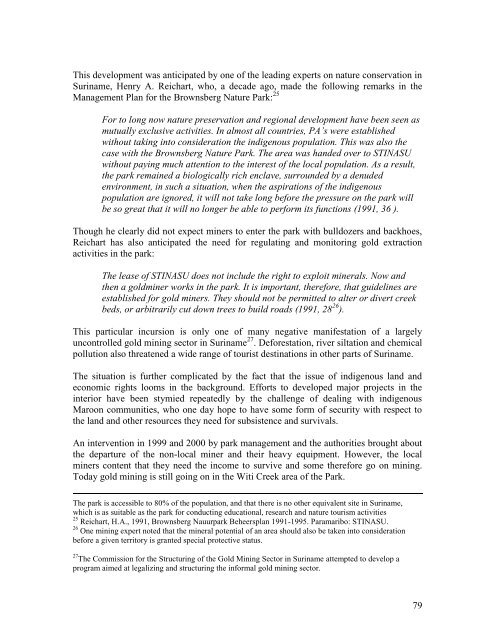SITUATION ANALYSIS OF THE SMALL-SCALE GOLD ... - WWF
SITUATION ANALYSIS OF THE SMALL-SCALE GOLD ... - WWF
SITUATION ANALYSIS OF THE SMALL-SCALE GOLD ... - WWF
You also want an ePaper? Increase the reach of your titles
YUMPU automatically turns print PDFs into web optimized ePapers that Google loves.
This development was anticipated by one of the leading experts on nature conservation in<br />
Suriname, Henry A. Reichart, who, a decade ago, made the following remarks in the<br />
Management Plan for the Brownsberg Nature Park: 25<br />
For to long now nature preservation and regional development have been seen as<br />
mutually exclusive activities. In almost all countries, PA’s were established<br />
without taking into consideration the indigenous population. This was also the<br />
case with the Brownsberg Nature Park. The area was handed over to STINASU<br />
without paying much attention to the interest of the local population. As a result,<br />
the park remained a biologically rich enclave, surrounded by a denuded<br />
environment, in such a situation, when the aspirations of the indigenous<br />
population are ignored, it will not take long before the pressure on the park will<br />
be so great that it will no longer be able to perform its functions (1991, 36 ).<br />
Though he clearly did not expect miners to enter the park with bulldozers and backhoes,<br />
Reichart has also anticipated the need for regulating and monitoring gold extraction<br />
activities in the park:<br />
The lease of STINASU does not include the right to exploit minerals. Now and<br />
then a goldminer works in the park. It is important, therefore, that guidelines are<br />
established for gold miners. They should not be permitted to alter or divert creek<br />
beds, or arbitrarily cut down trees to build roads (1991, 28 26 ).<br />
This particular incursion is only one of many negative manifestation of a largely<br />
uncontrolled gold mining sector in Suriname 27 . Deforestation, river siltation and chemical<br />
pollution also threatened a wide range of tourist destinations in other parts of Suriname.<br />
The situation is further complicated by the fact that the issue of indigenous land and<br />
economic rights looms in the background. Efforts to developed major projects in the<br />
interior have been stymied repeatedly by the challenge of dealing with indigenous<br />
Maroon communities, who one day hope to have some form of security with respect to<br />
the land and other resources they need for subsistence and survivals.<br />
An intervention in 1999 and 2000 by park management and the authorities brought about<br />
the departure of the non-local miner and their heavy equipment. However, the local<br />
miners content that they need the income to survive and some therefore go on mining.<br />
Today gold mining is still going on in the Witi Creek area of the Park.<br />
The park is accessible to 80% of the population, and that there is no other equivalent site in Suriname,<br />
which is as suitable as the park for conducting educational, research and nature tourism activities<br />
25 Reichart, H.A., 1991, Brownsberg Nauurpark Beheersplan 1991-1995. Paramaribo: STINASU.<br />
26 One mining expert noted that the mineral potential of an area should also be taken into consideration<br />
before a given territory is granted special protective status.<br />
27 The Commission for the Structuring of the Gold Mining Sector in Suriname attempted to develop a<br />
program aimed at legalizing and structuring the informal gold mining sector.<br />
79
















